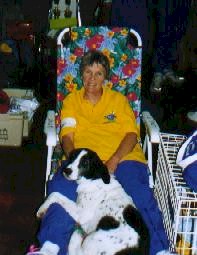The American agility scene
 American
ex-pat Mary Ann Nester has lived in England for the last twenty-eight years and admits that she
still says 'side-walk' instead of 'pavement.' It was time for her to go home and see the
family. American
ex-pat Mary Ann Nester has lived in England for the last twenty-eight years and admits that she
still says 'side-walk' instead of 'pavement.' It was time for her to go home and see the
family.
I found a week-end when I wouldn't be
missing an important show, arranged a dog-sitter and booked the airline tickets. I would only
be away a week, but I would need an agility fix. My husband suggested dropping in on some
agility clubs near my old home town. What a good idea!
Anne Smith lives a mere 24 miles from my
mother's house and holds agility classes in her back yard at Pound Ridge. She gave me a warm
welcome, and I loved every minute of my visit - even when it started to snow! Anne taught two
classes with breaks in between for coffee and chat. These people were agility educated and
up-to-date with the UK scene. They knew everyone's name, their dog's name and they were eager
to learn more.
- 'What did I think of the standard of mini agility
at Olympia this year?'
- 'Did I think jump heights would be lowered?'
- Would I take my dogs into Europe to compete?'
- 'Did I find the Crufts carpet slippery?'
- 'What did I think of the registration of cross breeds by Kennel clubs?'
These were people who could talk contacts -
my kind of people. We even had a quick comparison of UK vs. US trophies (bigger, of course) and
track suits. Anne pulled her USDAA team suit out of the closet, and I modelled my red Pedigree
Olympia fleece.
My agility fix for
the day
Despite having seen me with my Poodle, Daz, on the official Olympia video, Anne
generously let me run her two dogs. Sid ADCH is a old boy who knows his stuff forwards and
backwards, but I fell in love with youth and inexperience. Dingo AD is an Australian Cattle Dog
who is sleek, handsome and keen - not at all like a poodle! The exercises we tackled were a
joint international enterprise composed by Anne smith and Britain's Jo Sermon. The British
influence will continue when Jo visits Pound Ridge in May and Sally Jones follows in July. You
girls will have a lovely time - beautiful surroundings, lovely people and dogs you'll want to
pack in your suitcase. And, I bet it doesn't snow!
Next day, I was out in search of more
agility. I had the address for the Skyline Agility Club in Garnerville, New York and headed out
on the Palisades Parkway. They advertised their indoor training facility as 'heated and fully
matted, with plenty of crating space.' What they don't tell you is that it's upstairs on the
first floor! They boast that they haven't lost anyone out a window yet. I climbed the steps and
came face to face with Chris and Jeff Bolton who had been giving privet lessons and clinics all
week. You just can't get away from the Brits!
Assorted American
agility
I sat back and observed the scene before me. In two days of agility, I had seen a
Doberman with a tail and two dogs wearing pinch collars. I had seen only one Border Collie and
one cross breed. I saw more Portuguese Water Dogs than I had ever seen in my whole life. There
did not appear to be a breed of choice as there is in the UK - anything goes. As a result, it
was more fun to watch different dogs attempting the same exercise and more and more demanding
on the trainer. I applauded this diversity.
Flooring
I had studied the rubber matting carefully. Was I looking at a viable alternative to
the Crufts green carpet? They were about 3/4 inch thick and designed for use with horses in
stables. There were two mates sizes of about 6ft. x 4ft and 4ft. x 4ft and they were jig-sawed
together to cover the entire floor. The dogs looked secure and comfortable. I spoke to Chris
Miele, Skyline's President, who told me that there had been no impact injuries resulting from
using the mats, but there was one 'fast' collie who suffered occasional pad burns. Rubber mats
are an acceptable flooring in the States because they jump their dogs at a lower height than us
and concentrate on control rather than speed exercises.
 Jump
heights Jump
heights
Looking around, it was easy to make the mistake of thinking a dog was a beginner just because
the hurdle was 16". The American Kennel Club uses jump heights 8", 12", 16", 20" and 24"
whereas our Kennel Club uses 15", 20" and 30". I got the feeling that the Americans think we
are nuts for jumping our dogs over such high hurdles. I spoke to one lady who was aghast that
her King Charles Cavalier would be expected to jump15" in Britain. Most believe that it would
be injurious to their dogs to repeatedly ask them to over extend themselves. I tend to agree -
more height categories and a lower maximum height would be safer and fairer. I watched dogs
clearing the hurdles instead of knocking random poles and I'm sure that was because of
realistic height setting for each dog.
Allsorts of agility
Jump height, divisions, show format and awarded titles will vary with the rules and regulations
of the three main agility associations - American Kennel Club (AKC), United States Dog Agility
Association (USDAA) and the National Association of Dog Agility Clubs (NADAC). It all gets a
bit confusing! Competitors appear to have a firm allegiance either to one or the other. What
unites competitors is their desire for a clear run.
One lady asked me, 'What is the point of
competing if so few people win? Here, we compete for clean runs that gain legs towards titles
like Agility Dog Champion.
Having spent four years in starters, I knew
my answer to this one. Whatever dog I run, I aim for the best teamwork I can produce. What
results may not be what the judge has in mind, but it's been fun for someone. I don't think I'm
alone. But, I do like the American system of titles because it not only encourages but favors
handlers who train their dogs for accuracy and control. Speed is not necessarily a winning
ingredient. Much as I would like a title, I continue to resist the temptation to sign my emails
to the States with 'Idadoun Black Buttons AC (Agility Clown)'.
Agility tricks
In fact, all the American dogs I met were well-adjusted. Most were jacks of all
trades and proud of having titles in obedience and breeds as well as agility. I do like a
well-rounded dog! And not everything I was practiced with a title in view, but for the sheer
joy of it. Dogs waiting their turn on the course, practiced rolling over, covering their eyes
with their paws, and sitting up and begging. The dog that could wink on command was really
impressive!
I came home reassured. If the Home Office
ever decides to deport me I know that there are places I can go to in the States to Continue
enjoying my agility. And maybe one day, I can take my own dogs with me - they can wink with
both eyes at once!
 About
the author... About
the author...
Mary Ann Nester (left)
is a member of APDT. Born in the USA, she came to
Britain in 1972 as a student. She has pursued a mixed career - fruit picker, gymnastic coach,
keep-fit instructor and academic librarian. In 1997 she set up Aslan Enterprises, a
dog-training school named after her first agility dog.
Running Aslan, a lurcher dog, at agility
competitions got Mary Ann hooked on the sport and Bounty, a German Shepherd Dog, and Tam, the
Border Collie were soon added to the household.
Mary Ann's most successful dog to date has been Brillo
Pad, a Miniature Poodle who took her to Olympia and Crufts. Brillo also competed in the Draw
Challenge on National Lottery Live!, winning Mary Ann the privilege of pushing the button that
released the evening's lottery balls in front of millions of television viewers.
Daz, another miniature poodle and most recent addition,
was bought for competition in the Mini ring, but grew too tall! He has proved that size doesn't
matter. He entertained the crowds at Olympia as one of the 'fun dogs' and has strut his stuff
in the ABC competition (Any Breed but Collie) at Crufts.
Comment from Bonnie Harrington
about American agility. I believe that one of the reasons that we Americans like to
compete for titles is that agility is so expensive here. Entering a two day AKC show will cost
me at least $50.00 in entry fees, plus hotel and eating expenses. So most of the time I spend
$125.00 dollars or more for one week-end unless I'm lucky enough that the show is within
commute distance.
As Mary Ann said, there is a greater variety of dogs
competing here in the States. I'd hate to see that change. However, I am seeing more and more
people getting BC's the second time around. Personally don't know if I could handle that kind
of speed. They are wonderful.
Input by Rebecca Leslie
|